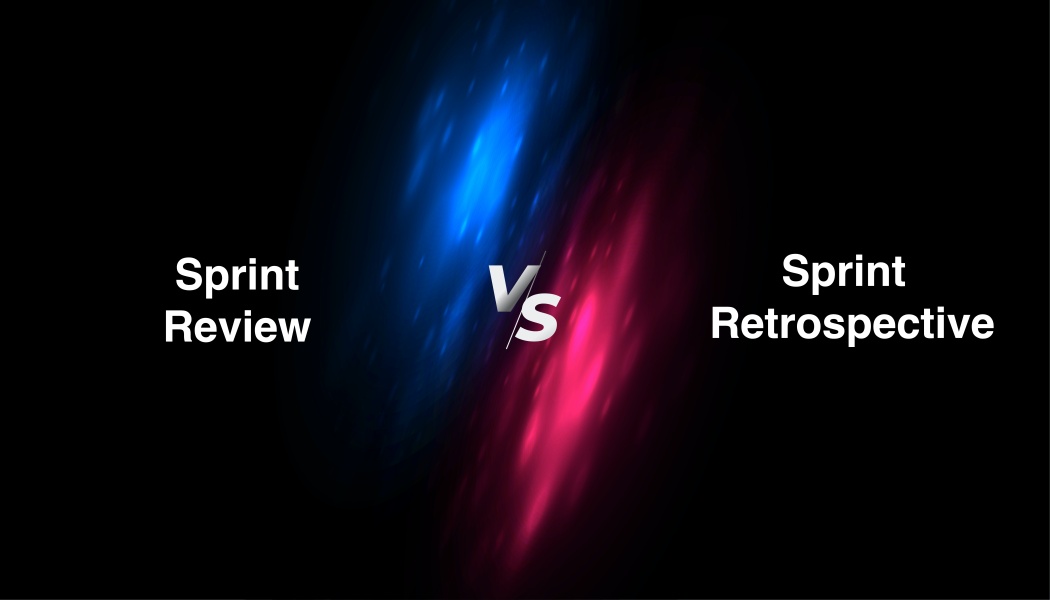Agile methodology has been widely adopted in software development and project management, primarily because it focuses on delivering incremental value to customers by using collaborative and flexible approaches. The heart of Scrum lies in its emphasis on continuous improvement . It’s not just about doing the work but also about refining how the work is done. This spirit finds its expression in these two ceremonies.
Two key ceremonies of the Agile framework are the sprint review and the sprint retrospective. While both processes offer insights into how the project is progressing, there are notable differences between the two. In this article, we’re going to look at the six key differences between a sprint review and a sprint retrospective.
What Is a Sprint?
Before we delve into the differences between the sprint review and sprint retrospective, let’s first define what a sprint is. A sprint is a time-boxed period during which the development team works on a set of prioritized items from the product backlog.
It is a fixed length of time, typically between one and four weeks, during which the team works to complete a specific set of tasks, with a shorter sprint resulting in a lesser workload.
Sprints provide a framework for the team to collaborate, communicate, and deliver working software incrementally. Each sprint starts with a sprint planning meeting, where the team decides which items from the product backlog they will work on during the sprint.
The sprint ends with a sprint review and a sprint retrospective, which we will explore in more detail in the following sections.
What Is a Sprint Review?
The sprint review is undertaken at the end of a sprint meeting and its purpose is to review the work completed during the sprint and to gather feedback from stakeholders. The review is an opportunity for the team to showcase their work and demonstrate how it aligns with the product vision and the sprint goal.
In each sprint, the Scrum team should produce a potentially shippable product increment. The sprint review is a meeting at the end of the sprint where the Scrum team and all stakeholders get together and discuss what has been accomplished during the sprint and whether the sprint goal has been met. The people attending the sprint review should include the product owner and product manager, Scrum Master, the development team, management, and anyone else involved.
During the sprint review, the team presents the completed work to the stakeholders, including the product owner, customers, and other interested parties. The team demonstrates the functionality of the features they have developed and gathers feedback from the stakeholders. The feedback gathered during the sprint review is used to inform the product backlog and to guide the team’s work in future sprints.
Sprint Review is a workshop at the end of a Scrum Sprint cycle where a Scrum Team reviews what was accomplished during the last Sprint. Based on this, the so-called product backlog is updated. The main focus of a Sprint review meeting is a working product increment, delivered during the Sprint, and, subsequently, the update of a product backlog. In other words, Sprint Review focuses on WHAT was done.
What Is a Sprint Retrospective?
The sprint retrospective is another meeting that takes place at the end of the sprint. Its purpose is to reflect on the team’s performance during the sprint and to identify areas for improvement. The sprint retrospective is an opportunity for the team to look back on the sprint and discuss what went well and what could have been done better.
Behind every successful Scrum team is a ritual of reflection. That ritual is the Sprint Retrospective meeting, or the “retro”.
During the sprint retrospective, the team discusses the sprint’s successes and challenges and identifies ways to improve their processes and collaboration. The goal of the sprint retrospective is to identify actionable items that the team can implement in the next sprint to improve their performance.
Are you looking to level up your agile game with sprint review and sprint retrospective?
Contact Growth Hackers
Key Differences Between Sprint Review and Sprint Retrospective
While the sprint review and sprint retrospective share some similarities, they have distinct differences that every agile team should understand. In the following sections, we will explore 6 key differences between sprint review and sprint retrospective.
1. Sprint Review Vs Sprint Retrospective: Purpose
Sprint Review and Sprint Retrospective have different purposes and serve different stakeholders. The purpose of the Sprint Review is to showcase the work done by the development team to the product owner and other stakeholders. The developers need to discuss problems they encountered during the sprint and how they were solved. The Scrum team answers sprint-related questions from the rest of the team. The team should discuss which tasks come next, which provides a great basis for the next spring planning meeting.
The development team presents a demo of the features or functionalities that they have completed during the sprint. The stakeholders provide feedback on the demo and suggest changes or improvements if required.
The Sprint Review is an opportunity for the development team to get validation for their work and ensure that they are on track with the product vision. It also helps in identifying any gaps or misalignments between the product owner’s expectations and the development team’s understanding of those expectations.
On the other hand, the purpose of the Sprint Retrospective is to reflect on the performance of the scrum development team during the sprint. The development team discusses what went well, what didn’t go well, and what can be improved in their processes, communication, collaboration, or any other aspect of their work. The goal of sprint retrospectives is to improve engineering productivity . By having this open space for reflection, the team can spot opportunities and risks, and take action to capitalize on the former and minimize the latter.
The Sprint Retrospective is an opportunity for the teams to learn from their mistakes, celebrate their successes, and continuously improve their development process. The output of the Sprint Retrospective is an action plan that outlines specific steps that the development team will take to improve their performance in the next sprint.
2. Sprint Review Vs Sprint Retrospective: Meeting Agenda
Both scrum events are important for ensuring that teams are continuously improving their work, but they serve different purposes and require different agendas. The Sprint Review focuses on gathering feedback from stakeholders, it typically includes a demonstration of the completed work, a review of the product backlog, and a discussion of any issues or challenges encountered during the sprint.
The Sprint Retrospective focuses on reflecting on past performance and identifying areas for improvement. It includes a demonstration of the completed work, a review of the product backlog, and a discussion of any issues or challenges encountered during the sprint. Both meetings provide an opportunity for team members to collaborate, share ideas, and learn from each other.
Typically, a Spring review meeting is scheduled for one hour per week of the Sprint if there’s a lot to discuss. On the other hand, retrospectives are typically held once every two weeks, with 30-45 minutes budgeted to cover each week of the Sprint. Be rigorous about the meeting agency.
It is always good idea to suggest planning the events in such fashion, that spring planning would actually start immediately after retrospective is finished, at the same room or same videoconference.
3. Sprint Review Vs Sprint Retrospective: Participants
The participants in both these ceremonies are different, and they serve different purposes. The Sprint Review is an opportunity for the Scrum Team to showcase the work they have completed during the sprint to the stakeholders.
The participants in this meeting include the Scrum Master and the Scrum Development Team from the Scrum Framework, and the Product Owner along with stakeholders such as customers, sponsors, and end-users.
The Development Team demonstrates the working software or product increment to the stakeholders, which they can inspect and provide feedback. The Product Owner can also update the stakeholders on the product backlog and prioritize it based on their feedback. The Sprint Review is an excellent opportunity for the stakeholders to ensure that the Scrum Team is working according to their expectations.
On the other hand, the Sprint Retrospective is a team-focused meeting where the Scrum Team reflects on the previous sprint’s performance. The participants in this meeting include only the Scrum Team and the product owner. While the sprint review helps you to regularly meet customer expectations, retrospectives allows scrum teams to become faster, smarter, and even happier. And that’s just scratching the surface.The sprint review is about the product, while the sprint retrospective is about the team.
The goal of this meeting is to identify what went well during the sprint and what didn’t go so well. The Scrum Team discusses ways to improve their processes, tools, and techniques to become more efficient and effective in the next sprint. The Sprint Retrospective is an opportunity for the team to learn from their mistakes and celebrate their successes.
While the Sprint Review focuses on gathering feedback from stakeholders, the Sprint Retrospective focuses on improving team collaboration and performance. By including all necessary participants in each ceremony, the Scrum Team ensures that everyone has a clear understanding of their roles and responsibilities toward achieving the common goal.
4. Sprint Review Vs Sprint Retrospective: Output
Sprint reviews are primarily focused on demonstrating the work that has been completed during the sprint. The output of this ceremony is a working product increment that has been validated by the stakeholders. The team showcases their work to the product owner and other stakeholders, highlighting the features and functionality they have developed.
The stakeholders provide feedback on the work completed, which helps the team to refine their backlog for the upcoming sprint. The output of the sprint review provides clarity on what has been accomplished and what needs to be done next.
The scrum team helps stakeholders to understand what was done during the sprint, and what was not completed (where relevant). They may also want to offer some level of explanation around why the sprint goal was not met (for example external factors became a blocker to them). Extended business context for developers. Business stakeholders and the product owner share with the developers the current market landscape and customer insights to hint at what might be the next development goals.
On the other hand, the sprint retrospective is focused on reflecting on the process of how work was completed during the sprint. The output of this ceremony is a set of action items that the team will implement in the upcoming sprints to improve their process and productivity.
During the retrospective, a team member can share his thoughts on what went well, what didn’t go well, and what can be improved. The team then works together to identify areas for improvement and develop a plan to address them in the next sprint. The output of the sprint retrospective helps teams to continuously improve their process and work more efficiently.
For a successful sprint retrospective meeting, each team member should try to answer the following sprint retrospective questions: What went well during the sprint? Is there anything that can be improved? How can we make those improvements?
Although these improvements may be implemented during the sprint, the sprint retrospective gives the Scrum team a formal opportunity to discuss the process and motivates each team member to voice their opinion and ideas.
5. Sprint Review Vs Sprint Retrospective: Timing
Sprint review meetings are typically held at the end of each sprint and their purpose is to showcase the work that was completed during the sprint to stakeholders. This meeting provides an opportunity for the team to demonstrate the new features and functionality that were developed and receive feedback from stakeholders.
The timing of the sprint review is important as it allows stakeholders to see the progress being made and provide input for the next sprint. It shouldn’t last for more than one hour per week. The Scrum Master needs to ensure the meeting doesn’t run longer than that. Aside from presenting the work done during the sprint, sprint review meetings should have a few other things on the agenda: The product owner needs to inform the team about the tasks that have been completed and those that are not yet done. The developers need to discuss problems they encountered during the sprint and how they were solved.
On the other hand, sprint retrospectives are held immediately after the sprint review and their purpose is to reflect on the previous sprint and identify ways to improve the team’s processes. The timing of the sprint retrospective is equally important as it allows team members to reflect on their work while it’s still fresh in their minds and make necessary adjustments for future sprints.
The sprint review provides an opportunity for stakeholders to see progress and provide feedback, while the sprint retrospective allows team members to reflect on their work and make improvements. By holding these meetings at appropriate times, teams can ensure that they are continuously improving their processes and delivering high-quality products to their customers.
Maximize teamwork and project success with sprint review and sprint retrospective today!
6. Sprint Review Vs Sprint Retrospective: Focus
The Sprint Review meeting is held at the end of each sprint to showcase the work completed during that sprint. The focus of this meeting is on the product, its features, and how it meets the customers’ needs. Sprint retrospectives are organized and run by the scrum master. However, product managers should also participate because healthy discussions are most likely to occur when every team member is present. Fostering productive discussions and an open environment in which everyone is empowered to speak is the responsibility of every participant in the sprint retrospective. That includes product managers.
On the other hand, the Sprint Retrospective meeting is held after the Sprint Review to reflect on how the team worked during the sprint. The focus of this meeting is on the team’s performance, their process, and how they can work better together.
In a brief manner of understanding, the Sprint Review focuses on showcasing the completed work and receiving feedback from stakeholders, while the Sprint Retrospective focuses on reflecting on the team’s performance and identifying areas of improvement. The two meetings are critical for project success and must be conducted regularly with equal importance.
Sprint Review Vs Sprint Retrospective: Which Is More Important?
The two scrum ceremonies are important in agile project management. The sprint review is essential for gathering feedback from stakeholders and ensuring that the team is aligned with the product vision and goals. The sprint retrospective is equally important for reflecting on the team’s performance and identifying areas for improvement.
It is crucial to note that the sprint review and sprint retrospective are complementary ceremonies, and one should not be prioritized over the other. The sprint review and sprint retrospective work together to ensure that the team is continuously improving and delivering value to the customer.
Final Thoughts on Sprint Review Vs Sprint Retrospective – 6 Key Differences
Sprint Review vs Sprint Retrospective – What Is the Difference? The sprint review and retrospective are the final two steps of the Scrum sprint cycle. Sprint reviews and sprint retrospectives are two important ceremonies in agile project management. They are the closing steps to the sprint cycle. While they share some similarities, they have distinct differences that every agile team should understand.
By understanding the differences between the scrum events, agile teams can use these ceremonies effectively to improve their performance and deliver value to the customer. Remember, the sprint review and sprint retrospective are complementary ceremonies, and one should not be prioritized over the other. Both are essential for effective agile project management.
For more such advice concerning the sustainability of your online business, Growth Hackers knows the ideal strategies you can incorporate to gain success according to your business requirements.
At Growth Hackers, our core ethos centers around ensuring sustainable business development through the implementation of cutting-edge digital marketing strategies. Leveraging our global success as a digital marketing agency, we offer bespoke solutions tailored to your unique business requirements, ensuring that you receive the right support to achieve your growth objectives.
Our approach is anchored in data-driven insights and result-driven analysis, giving you access to better leads and sales and delivering an impressive return on investment. From harnessing the power of social media to optimizing your website and search engine rankings, trust us to help unlock your full business potential through the power of digital marketing.
Contact Growth Hackers today without delay and experience the feeling of watching your business grow by the day, faster, smarter, and with strategies that bring results with every implementation.








